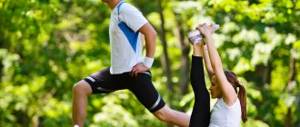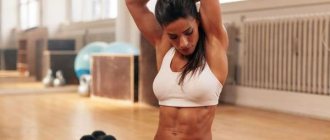Is it possible to stretch before training?
Stretching before a workout is as important to the muscles as warm-up exercises, but without them, stretching cold muscles can be dangerous, meaning stretching can end the workout before it even begins.
Stretching exercises will prepare the muscles for loads in which the fibers will have to both contract and stretch, as well as overcome obstacles or perform various tricks. Therefore, pre-stretching will help avoid injury and improve workout performance.
You only need to stretch well-warmed muscles, spending 7-10 minutes warming up. And only after the muscles and ligaments have warmed up can they be stretched.
How to properly warm up before playing sports
Warming up before training can take from 7 to 10 minutes. High-quality warming up consists of the following stages:
- More intense cardio - 2 minutes.
- Gymnastics for joints – 2 minutes.
- Stretching exercises – 3 minutes.
- Another stage of cardio (more intense) – 3 minutes.
- Restoration of breathing – 1 minute.
Aerobic training (cardio) helps to increase body temperature, accelerate blood flow, and prepare the muscles for further stress. Gymnastics for joints will increase their functionality, make tendons and ligaments more elastic, more mobile, and help work out the muscles around bone structures. Thanks to dynamic stretching, you can better stretch your muscles and prepare them for the main workout.
A multi-stage warm-up is not at all difficult, but it will speed up the heartbeat, blood flow, and awaken all muscle fibers. After it is carried out, warmth appears in the body, the athlete will feel a surge of energy.
Some athletes don't understand the difference between a warm-up and a cool-down. The difference is that the warm-up part is fast, and the cool-down after training is slow. The first is needed to warm up the body before exercise, and the second is needed to gradually cool and calm the body.
Before you start exercising, study the following features of the warm-up phase:
- When performing exercises to develop joints, start kneading the body from above (neck, shoulders, elbows, waist and below).
- The pace of work should be dynamic, but moderate.
- Gradually increase the pace and width of movements.
- During the cardio phase, you can work out on a treadmill, elliptical or exercise bike.
- Before training a specific part of the body, such as legs and buttocks, stretch the hip and knee joints longer, and stretch the muscles of the lower body.
Important! All movements during warm-up should be fast but smooth. If pain occurs, stop the activity.
What stretching exercises should you do before strength training?
The difficulty of the stretching exercises also plays an important role. In the preparatory stage for training, you do not need to immediately do the splits, perform swings or complex yoga asanas. It is only necessary to relax and slightly increase the elasticity of the ligaments and fibers, so the impact on them should be minimal.
Before training, it is necessary to warm up all muscle groups that will not only directly participate in the load, but also stabilize the body, that is, receive a static load. Therefore, it is important to warm up both the muscles of the neck and torso, including the abdominal muscles, and, of course, the legs.
Expert opinion
Professional bodybuilders and fitness trainers say that it is better to spend 10-15 minutes warming up your muscles in the gym than to then undergo lengthy treatment and a recovery period of several weeks or months. The warm-up stage helps to warm up the muscle fibers and prepare the entire body for heavier loads. Athletes can perform aerobic exercise, joint exercises, or stretching. But the best option is a combination of these three sports. According to experts, a proper warm-up should last about 15 minutes, and it should be done at a fast pace, but smoothly.
Alexey Shaev, bodybuilder
An experienced bodybuilder advises men to abandon cardio exercises in favor of joint gymnastics before strength training to develop mass. Aerobic exercise burns calories and does little to warm up the core muscles, so the risk of injury remains. It is better to do gymnastics for your joints in the gym, thoroughly warm up your neck, shoulders, elbows, etc. Then it is recommended to stretch the muscles of the chest, back, and lower back. After this, you can move on to the main workout. A. Shaev advises not to forget about gentle stretching after class.
Stas Lindover, bodybuilder
A famous trainer reveals the secrets of a perfect warm-up:
- Cardio exercise should last up to 5 minutes.
- Exercises to develop joints before training will help prevent injuries to the bone joints and soft tissues that surround them.
- Do some stretching before your main workouts in the gym, as well as between them.
- Start with the basic elements with an empty bar, then put weights on the bar and repeat.
S. Lindover advises warming up for no longer than 10-15 minutes, but moving quickly.
Ashot Kagramanyan, bodybuilder
According to a professional bodybuilder, warming up is an essential part of a quality workout. It will help warm up muscle fibers before strength training and also avoid injury. A. Kagramanyan claims that cardio exercise can be skipped if the body temperature is high enough, however, joint exercises and strength warm-up with minimal weight are necessary. The more weight of sports equipment is used, the more warm-up approaches need to be carried out. For example, while pumping your chest in the gym, do 4-5 warm-up sets, and legs - from 5 to 6, while gradually increasing the weight of the equipment.
Pre-workout stretching routine
All exercises are suitable for home and gym.
Head tilts to the sides
The exercise stretches the neck muscles. To perform it, tilt your head to the side without raising your shoulders. You can apply additional pressure on the head from above with your hand, increasing the traction. The second hand must be moved in the opposite direction from the head, stretching the neck muscles even more. Same for the other side.
Tilts the head back and forth
Traction of the front and back of the neck can be performed either statically or dynamically. To stretch the muscles of the back surface, tilt your head forward, aiming your chin towards your collarbones. Under the weight of the head, the muscles will gradually stretch.
To stretch from the front, do not tilt your head back too much, just stretch your chin towards the ceiling, feeling the stretch without putting too much pressure on the cervical vertebrae.
Read more about neck stretching exercises →
Forward bend and lumbar arch
To stretch your back muscles, tilt your torso forward, grab your shins and feel a comfortable stretch in the muscles of the back of your body. Do not spring and do not try to press your stomach to your thighs.
When performing a backbend, the abdominal muscles are stretched. Perform a slight bend in the thoracic region, moving your head back. Support your lower back with your palms.
Retracting the arm back
To stretch the chest muscles, you need to stand at the doorway and place your palm at the level of the shoulder joint. Then turn away from your arm and feel the stretch in the muscles of your shoulder and chest. Performed on both hands.
Reverse tilt lock
Complex stretching of the muscles of the back surface of the body and shoulder girdle. While standing, form a lock with your palms behind your back and smoothly lean forward as far as your muscles allow. Completely relax your torso and head. Keep your hands free.
Lateral bending of the torso
To stretch the lateral muscles of the body, you need to clasp your hands above your head. When bending, the pelvis and lumbar region should remain in place, the deflection is carried out mainly in the thoracic region.
Pulling the arm back by the elbow
You can perform the exercise sitting or standing. Raise your arm above your head, bending at the elbow. Using your other hand, use gentle pressure to pull your shoulder behind your head. Don't make it painful. Change to the other hand.
Tilt to hip
Place your feet wide. Bend your torso forward. Grabbing your shin with your hands, pull your stomach towards your thigh. Hold for a few seconds, then repeat on the other side.
Standing hip extension
To stretch the front of your thigh, stand straight, bend the knee of one leg and grab your foot with your hand, pressing your heel towards your buttocks. Knees together. Change to the other side.
And to stretch the back surface, place one straight leg in front of you on the heel and bend forward. Repeat on the other leg.
Stretching the back and chest muscles
Sit on the floor with your legs crossed. Palms in the lock. Bring your arms back above your head, forming a arch in your chest.
To stretch your back, place your legs in front of you with your knees bent. Place your palms in a lock, clasping your thighs. Round your back by lengthening your back muscles and shoulders.
Features of warming up for girls and men
There are no separate exercises for women and men. Representatives of both sexes can perform the same movements, the only difference is in the distribution of the load. Guys usually focus on the core, while girls focus on the lower body. This is due to the fact that women are more interested in developing the abs, buttocks, legs, and men are more interested in developing the shoulders, arms, and chest.
Guys can do aerobic exercises longer, and girls can do stretching. Representatives of the stronger sex prefer to train at a more intense pace, but quickly. Women can increase the duration of the warm-up, but perform the exercises more smoothly. But, in any case, it is important to warm up the muscles before training.











